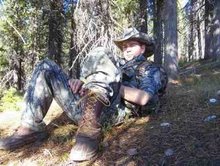NWTF Press Release - Largest Study of its Kind Collects Data for Second Year

A four-year study, one of the largest studies of its kind, is relying on spring hunters to report their hunting successes when a banded bird is harvested. If data shows that spring turkey hunting seasons have little affect on populations, seasons could expand or hunting hours increase. Currently, wild turkey hunting seasons open in late April in Ohio and Pennsylvania, while the New York season opens on May 1.
Each banded bird will have a unique letter-number combination secured to its leg. Bands will also have a toll-free telephone number to report gobbler harvests or recoveries. A percentage of the leg bands can be redeemed by hunters for a $100 reward. The rewards, funded by the National Wild Turkey Federation, help ensure consistent and accurate reporting of harvest information.
While no band return data will be available for the 2007 season for a few months, Penn State researchers are geared up to receive telephone calls from the hunters who take banded gobblers," said Bob Eriksen, NWTF regional biologist. "If last year is typical, we may see band returns from 25-30% or so of the birds marked this winter."
The study was designed to collect harvest rate data, which is important in evaluating the impact of hunting seasons on populations and producing accurate population estimates. The goal for 2007 was to band 300 gobblers in each of the three states --Pennsylvania, New York and Ohio, and biologists exceeded that goal by trapping a total of 995 gobblers. In 2006, 708 gobblers were banded.
In the past, individual states or, at most, two adjacent states have participated in wild turkey banding studies. Most of these studies only focus on selected regions. The Tri-State Gobbler Banding Study, now in its second year, involves statewide research in three states with some of the country's strongest turkey hunting numbers. The combined average spring gobbler harvest in these three states is about 79,000 birds.
Biologists will use new data -- gobbler harvest numbers, general survival rates, distances moved, hunter numbers and differences in habitat types -- to not only determine hunting season dates, but also consider adjustments to other management decisions including bag limits and expanding hunting opportunity through all day hunting and youth hunting days.
Decisions made based on study data will positively impact hunters and non-hunters alike by enhancing knowledge about habitat use and regional differences in turkey numbers, strengthening wildlife population information and ultimately making better use of the country's natural resources.
The project is funded through a research grant from the National Wild Turkey Federation; the organization committed more than $33,000 in 2006 and $38,000 for 2007. The Pennsylvania State University is coordinating the study and analyzing data, while each state's wildlife agency is providing personnel and equipment to capture and band 300 gobblers each winter during the study (2006-2009).
"Our objective is to have as many as 3,600 gobblers banded in the course of this four year effort," said Dr. Duane Dieffenbach, of Penn State University.
The NWTF's Pennsylvania State Chapter contributed more than $16,000 to the project in 2006 for the purchase of new rocket nets, rocket charges, detonators, testing devices and supplies.
For more information about the Tri State Gobbler Study or the NWTF's support of wildlife research, please contact NWTF regional biologist, Bob Eriksen at (908) 454-1882. For more information about state wildlife agencies involved in this project, visit agency Web sites: New York State Department of Environmental Conservation at http://www.dec.state.ny.us/, Ohio Division of Wildlife at http://www.dnr.state.oh.us/, and the Pennsylvania Game Commission at http://www.pgc.state.pa.us/.
